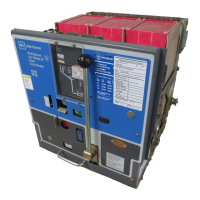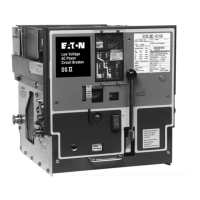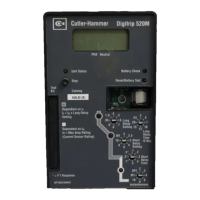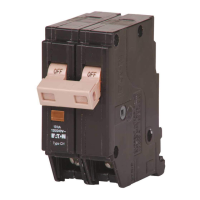Page 12
1.8. 33-790-11
Section 4 - Basic Operating Instructions
4.0 GENERAL
The breaker is now ready for trial mechanical operation.
Keep the breaker standing
on
the compartment rails, out
in
front
of
the compartment. Examine it externally for any
signs
of
obvious damage
or
foreign material. When
everything appears to be
in
order, perform the following
operations as "dry run" practice.
If
any malfunctioning is
found during these operations, see that it is corrected
before further operations
or
before placing the breaker
in
service.
Fig. 9 Method Used to Press Trip Plate
and
Lower
Shutter with One Hand, Preparatory to
Inserting Crank (383028)
4.1
LEVERING DEVICE
If
the circuit breaker was shipped
in
a separate package,
the levering device was probably left
in
the REMOVE
position.
If
not it will be necessary to return it to this posi-
tion. Push
in
the TRIP plate and depress the shutter over
the levering shaft, using one hand, as shown
in
Figure
9,
and insert the levering crank as shown
in
Figure
3.
Turn
the crank counterclockwise until the position indicator is
in
the REMOVE position, at which time the load
on
the
crank handle increases because a stop has been
reached. Now rotate the crank clockwise to simulate
levering the breaker inward toward the CONNECT POSI-
TION. Watch the movement
of
the levering device arms.
At the start
of
cranking the arms are horizontal, with roll-
ers toward the rear, Figure
6.
As the crank is turned
clockwise the levering device arms rotate downward.
When they have moved approximately 40° from the hori-
zontal, the shutter will rise until it touches the crank
socket. The position indicator will be opposite "DISC"
which is the DISCONNECT position wherein the breaker
is held
in
its compartment with both main and secondary
contacts disengaged.
If
the crank is withdrawn, the shut-
ter will close completely, and the breaker may be locked
in
this position as later described
in
Section 5.1.8.5
of
this
instruction book. There is very little movement
of
the
breaker into its compartment between the REMOVE and
DISCONNECT positions.
Continued rotation
of
the crank
in
the clockwise direction
moves the arms downward to the vertical position, and
the indicator will show "TEST' as
in
Figure
7.
The shutter
will rise.
Further clockwise rotation
of
the crank handle rotates the
arms to the CONNECT position. This is about 65 degrees
from the test position, as shown
in
Figure
8.
When this
position is reached, the crank suddenly becomes hard to
turn.
At
this point, stop turning the crank, as the worm
shaft bottoms
in
the tapped hole
of
the stop nut.
Note: Further turning effort
is
useless. The breaker
will be secure, even if the stop
is
only lightly
touched. Remember this when actually levering the
breaker into the connect position.
Rotation
of
the crank counterclockwise will turn the lever-
ing device arms to withdraw the unit from the CONNECT
position to the TEST position and then to the DISCON-
NECT and REMOVE positions. Then, when the crank is
removed from the worm shaft, the shutter will remain
down and the trip plate will remain trapped by the shutter.
Note: If the breaker is levered out from the TEST
position to the REMOVE position with the closing
springs charged, a trip-free "closing" operation auto-
matically will be performed but the breaker contacts
will not close. When a power-operated breaker
is
removed from cell, it must go through a trip-free
operation.
4.2 CHARGE THE CLOSING SPRINGS
The closing springs must be charged before the breaker
can be closed. To manually charge the closing springs,
the levering device arms must be rotated away from the
Effective October 1998
Courtesy of NationalSwitchgear.com

